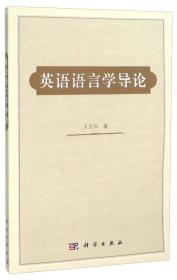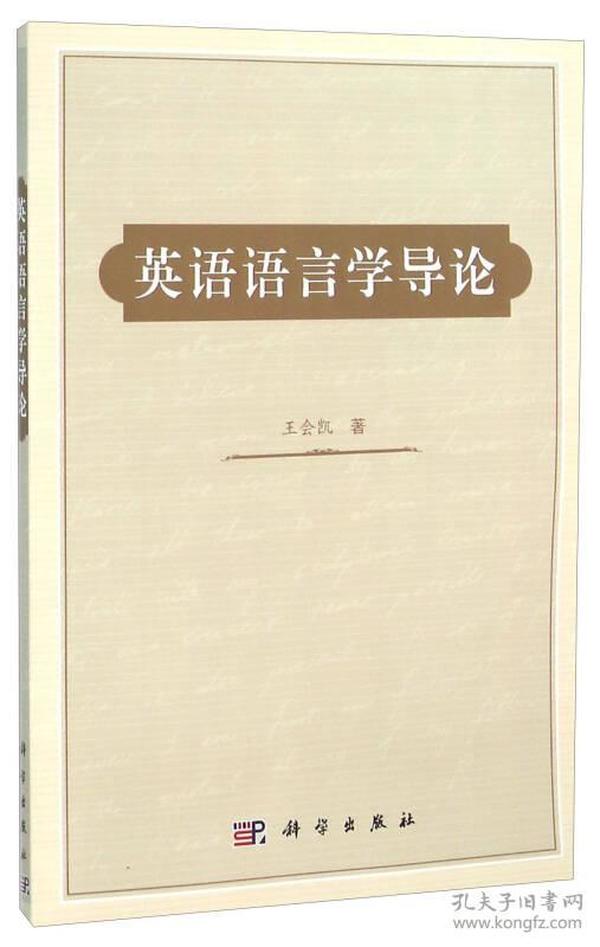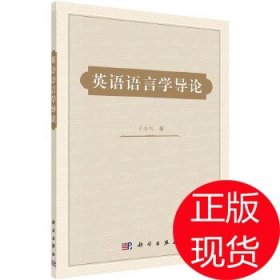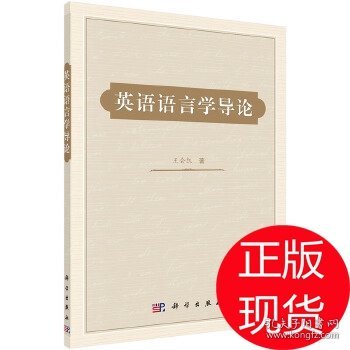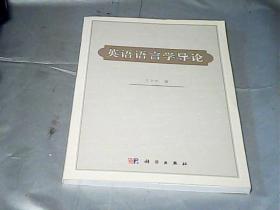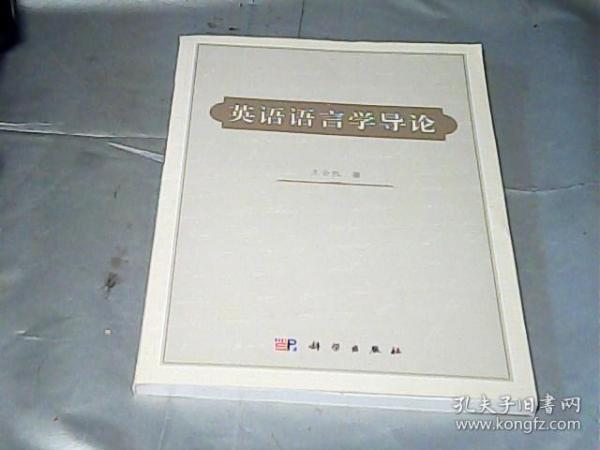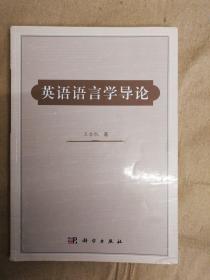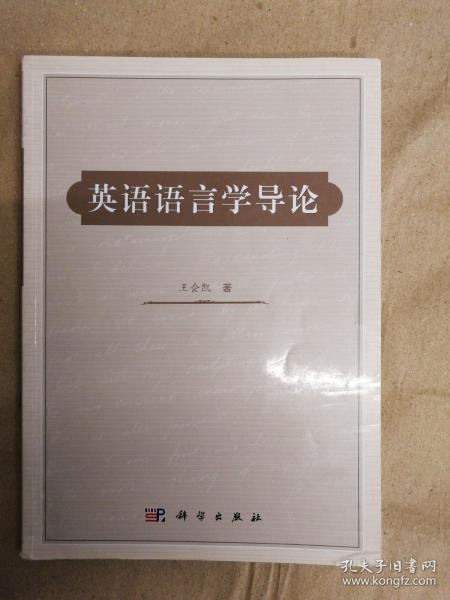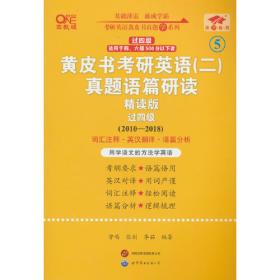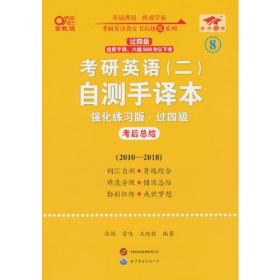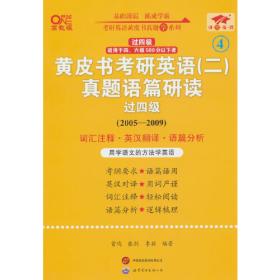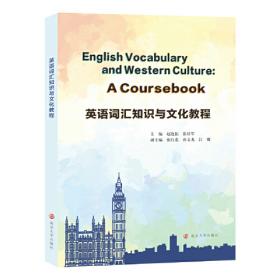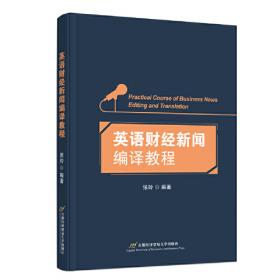英语语言学导论
出版时间:
2014-08
版次:
1
ISBN:
9787030417336
定价:
59.00
装帧:
平装
开本:
16开
纸张:
胶版纸
页数:
150页
字数:
245千字
正文语种:
简体中文,英语
3人买过
-
《英语语言学导论》根据作者王会凯多年研究英语语言学的积累编写而成。全书共11章,分别是 Invitation to Linguistics; Phonetics; Phonology; Morphology; Syntax; Semantics; Pragmatics; Language, Culture and Society; First Language Acquisition; Second Language Acquisition; Linguistics and Foreign Language Teaching and Leaning。《英语语言学导论》内容紧凑精炼,语言文字简洁易懂,同时配有鲜活生动的语言材料,能进一步帮助读者理解语言学的理论。
《英语语言学导论》可以作为普通高等院校英语专业学生的教材,也可以作为中学英语教师的培训材料和英语语言学爱好者的参考读物。 Chapter 1 Invitation to Linguistics
1.1 Linguistics
1.1.1 What is Linguistics
1.1.2 The Scope of Linguistics
1.1.3 Important Distinctions in Linguistics
1.2 Language
1.2.1 Design Features of Language
1.2.2 Origin of Language
1.2.3 Functions of Language
Chapter 2 Phonetics
2.1 What is Phonetics
2.2 Speech Organs
2.3 Phonetic Transcription
2.4 Classification of English Speech Sounds
2.4.1 Consonants
2.4.2 Vowels
2.5 Coarticulation and Phonetic Transcription
2.5.1 Coarticulation
2.5.2 Phonetic Transcription
Chapter 3 Phonology
3.1 Phoneme and Allophones
3.1.I Phoneme and Allophones
3.1.2 Contrastive Distribution and Minimal Pair
3.2 Phonological Rules
3.3 Syllable
3.3.1 Syllable Structure
3.3.2 Syllabification and the Maximal Onset Principle
3.4 Supra-segmental Features
3.4.1 Stress
3.4.2 Tone
3.4.3 Intonation
Chapter 4 Morphology
4.1 Word
4.1.1 What isaWord
4.1.2 Classification of Words
4.1.3 Word Structure
4.2 Two Fields in Morphology
4.2.1 Inflection
4.2.2 Word Formation
4.3 Morphophonology
4.4 Lexical Change
4.4.1 Phonological Change
4.4.2 Morphological Change
4.4.3 Syntactical Change
4.4.4 Semantic Change
Chapter 5 Syntax
5.1 Traditional Grammar
5.1.1 Parsing
5.1.2 Categories
5.1.3 Syntactic Relationships Between Words in Sentences
5.2 The Structural Approach
5.2.1 Immediate Constituent Analysis (IC Analysis)
5.2.2 Syntactic Relationships in Structuralism
5.3 Transformational-Generative (TG) Grammar
5.3.1 Generative Grammar
5.3.2 Transformational Grammar
5.3.3 Using PSR to Analyze Sentences
5.4 Systemic-Functional'Grammar
Chapter 6 Semantics
6.1 Meaning of "meaning" or "to mean"
6.1.1 The Naming Theory/Referential Theory
6.1.2 Meaning as Context
6.1.3 Meaning as Truth Condition
6.2 Types of Word Meaning
6.3 Lexical Sense Relations
6.3.1 Synonymy
6.3.2 Antonymy
6.3.3 Hyponymy
6.4 Componential Analysis
6.5 Sense Relations Between Sentences
Chapter 7 Pragmatics
7.1 What is Pragmatics
7.2 Micro-pragmatics
7.3 Macro-pragmatics
7.3.1 Speech Act Theory
7.3.2 Conversational Implicature
Chapter 8 Language, Culture and Society
8.1 Language, Thought and Culture
8.2 Language and Society
8.2.1 Language Variation
8.2.2 Standard and Non-standard Language
Chapter 9 First Language Acquisition
9.1 What is Language Acquisition
9.2 Theories of Language Acquisition
9.2.1 Behaviorist Theory
9.2.2 Innatist Theory
9.2.3 Interactionist Theory
9.3 Language Environment and Critical Period Hypothesis
9.3.1 Language Environment
9.3.2 Critical Period Hypothesis
Chapter 10 Second Language Acquisition
10.1 What is Second Language Acquisition
10.2 L1 Acquisition and L2 Acquisition
10.3 Approaches to L2 Acquisition
10.3.1 Contrastive Analysis
10.3.2 Error Analysis
10.3.3 Interlanguage Analysis
10.4 Factors Influencing L2 Acquisition
Chapter 11 Linguistics and Foreign Language Teaching and Learning
11.1 Introduction
11.2 Linguistic Views and Language Teaching
11.2.1 The Traditional Grammar
11.2.2 Structural Linguistics
11.2.3 Transformational-Generative Grammar
11.2.4 Functional Linguistics
11.2.5 The Theory of Communicative Competence
11.3 Syllabus Design
11.3.1 What is Syllabus
11.3.2 Types of Syllabus
11.4 Linguistics and Language Learning
11.4.1 Grammar and Language Learning
11.4.2 Language Input and Language Learning
11.4.3 Interlanguage in Language Learning
Bibliography
-
内容简介:
《英语语言学导论》根据作者王会凯多年研究英语语言学的积累编写而成。全书共11章,分别是 Invitation to Linguistics; Phonetics; Phonology; Morphology; Syntax; Semantics; Pragmatics; Language, Culture and Society; First Language Acquisition; Second Language Acquisition; Linguistics and Foreign Language Teaching and Leaning。《英语语言学导论》内容紧凑精炼,语言文字简洁易懂,同时配有鲜活生动的语言材料,能进一步帮助读者理解语言学的理论。
《英语语言学导论》可以作为普通高等院校英语专业学生的教材,也可以作为中学英语教师的培训材料和英语语言学爱好者的参考读物。
-
目录:
Chapter 1 Invitation to Linguistics
1.1 Linguistics
1.1.1 What is Linguistics
1.1.2 The Scope of Linguistics
1.1.3 Important Distinctions in Linguistics
1.2 Language
1.2.1 Design Features of Language
1.2.2 Origin of Language
1.2.3 Functions of Language
Chapter 2 Phonetics
2.1 What is Phonetics
2.2 Speech Organs
2.3 Phonetic Transcription
2.4 Classification of English Speech Sounds
2.4.1 Consonants
2.4.2 Vowels
2.5 Coarticulation and Phonetic Transcription
2.5.1 Coarticulation
2.5.2 Phonetic Transcription
Chapter 3 Phonology
3.1 Phoneme and Allophones
3.1.I Phoneme and Allophones
3.1.2 Contrastive Distribution and Minimal Pair
3.2 Phonological Rules
3.3 Syllable
3.3.1 Syllable Structure
3.3.2 Syllabification and the Maximal Onset Principle
3.4 Supra-segmental Features
3.4.1 Stress
3.4.2 Tone
3.4.3 Intonation
Chapter 4 Morphology
4.1 Word
4.1.1 What isaWord
4.1.2 Classification of Words
4.1.3 Word Structure
4.2 Two Fields in Morphology
4.2.1 Inflection
4.2.2 Word Formation
4.3 Morphophonology
4.4 Lexical Change
4.4.1 Phonological Change
4.4.2 Morphological Change
4.4.3 Syntactical Change
4.4.4 Semantic Change
Chapter 5 Syntax
5.1 Traditional Grammar
5.1.1 Parsing
5.1.2 Categories
5.1.3 Syntactic Relationships Between Words in Sentences
5.2 The Structural Approach
5.2.1 Immediate Constituent Analysis (IC Analysis)
5.2.2 Syntactic Relationships in Structuralism
5.3 Transformational-Generative (TG) Grammar
5.3.1 Generative Grammar
5.3.2 Transformational Grammar
5.3.3 Using PSR to Analyze Sentences
5.4 Systemic-Functional'Grammar
Chapter 6 Semantics
6.1 Meaning of "meaning" or "to mean"
6.1.1 The Naming Theory/Referential Theory
6.1.2 Meaning as Context
6.1.3 Meaning as Truth Condition
6.2 Types of Word Meaning
6.3 Lexical Sense Relations
6.3.1 Synonymy
6.3.2 Antonymy
6.3.3 Hyponymy
6.4 Componential Analysis
6.5 Sense Relations Between Sentences
Chapter 7 Pragmatics
7.1 What is Pragmatics
7.2 Micro-pragmatics
7.3 Macro-pragmatics
7.3.1 Speech Act Theory
7.3.2 Conversational Implicature
Chapter 8 Language, Culture and Society
8.1 Language, Thought and Culture
8.2 Language and Society
8.2.1 Language Variation
8.2.2 Standard and Non-standard Language
Chapter 9 First Language Acquisition
9.1 What is Language Acquisition
9.2 Theories of Language Acquisition
9.2.1 Behaviorist Theory
9.2.2 Innatist Theory
9.2.3 Interactionist Theory
9.3 Language Environment and Critical Period Hypothesis
9.3.1 Language Environment
9.3.2 Critical Period Hypothesis
Chapter 10 Second Language Acquisition
10.1 What is Second Language Acquisition
10.2 L1 Acquisition and L2 Acquisition
10.3 Approaches to L2 Acquisition
10.3.1 Contrastive Analysis
10.3.2 Error Analysis
10.3.3 Interlanguage Analysis
10.4 Factors Influencing L2 Acquisition
Chapter 11 Linguistics and Foreign Language Teaching and Learning
11.1 Introduction
11.2 Linguistic Views and Language Teaching
11.2.1 The Traditional Grammar
11.2.2 Structural Linguistics
11.2.3 Transformational-Generative Grammar
11.2.4 Functional Linguistics
11.2.5 The Theory of Communicative Competence
11.3 Syllabus Design
11.3.1 What is Syllabus
11.3.2 Types of Syllabus
11.4 Linguistics and Language Learning
11.4.1 Grammar and Language Learning
11.4.2 Language Input and Language Learning
11.4.3 Interlanguage in Language Learning
Bibliography
查看详情
-
全新
山东省泰安市
平均发货22小时
成功完成率86.83%
-
英语语言学导论
正版库存一手书,品相视出版时间长短而定,自然成色,可开电子发票,图片由软件自动采集,以书名为准,不以图片不符售后!
全新
山东省泰安市
平均发货7小时
成功完成率89.52%
-
全新
山东省泰安市
平均发货11小时
成功完成率95.16%
-
九品
北京市昌平区
平均发货22小时
成功完成率87.04%
-
英语语言学导论
正版图书,可开发票。团购业务电话15510117573
全新
河北省保定市
平均发货18小时
成功完成率81.55%
-
九品
北京市通州区
平均发货10小时
成功完成率87.58%
-
九品
北京市通州区
平均发货9小时
成功完成率92.94%
-
全新
北京市昌平区
平均发货23小时
成功完成率96.07%
-
全新
北京市通州区
平均发货38小时
成功完成率76.42%
-
英语语言学导论
正版书籍,放心下单。绝大部分是新书,个别品相折痕的,我们会主动联系哦
全新
北京市东城区
平均发货16小时
成功完成率86.03%
-
全新
北京市通州区
平均发货42小时
成功完成率77.01%
-
全新
北京市通州区
平均发货31小时
成功完成率84.86%
-
全新
北京市通州区
平均发货35小时
成功完成率79.07%
-
全新
河北省保定市
平均发货5小时
成功完成率83.29%
-
全新
北京市通州区
平均发货51小时
成功完成率82.35%
-
八五品
内蒙古呼和浩特市
平均发货7小时
成功完成率100%
-
全新
北京市房山区
平均发货10小时
成功完成率80.73%
-
全新
山东省泰安市
平均发货11小时
成功完成率95.16%
-
英语语言学导论
重要提醒:::重要提醒::所有图书保证正版,按书名发货图片仅供参考, 有疑问请咨询客服,看清书名按书名发货
全新
北京市通州区
平均发货10小时
成功完成率90.36%
-
英语语言学导论
正版现货,品相完好,套书和多封面版本的书咨询客服后再下单
九品
北京市海淀区
平均发货20小时
成功完成率82.53%
-
全新
河北省保定市
平均发货21小时
成功完成率77.71%

 占位居中
占位居中


